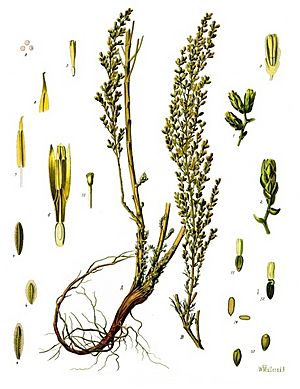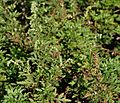Artemisia facts for kids
Quick facts for kids Artemisia |
|
|---|---|
 |
|
| Artemisia cina (Levant wormseed) | |
| Scientific classification |
|
| Kingdom: | Plantae |
| Clade: | Tracheophytes |
| Clade: | Angiosperms |
| Clade: | Eudicots |
| Clade: | Asterids |
| Order: | Asterales |
| Family: | Asteraceae |
| Supertribe: | Asterodae |
| Tribe: | Anthemideae |
| Genus: | Artemisia L. |
| Type species | |
| Artemisia vulgaris L.
|
|
| Synonyms | |
|
|
Artemisia is a large group of plants that belong to the daisy family, called Asteraceae. There are between 200 and 400 different kinds of Artemisia plants. Some common names for these plants are mugwort, wormwood, and sagebrush.
Artemisia plants can be herbaceous plants (plants with soft stems) or shrubs (small bushes). They are known for strong chemicals in their essential oils. These plants grow in places with mild weather, usually in dry or partly dry areas. Famous types include A. vulgaris (common mugwort), A. tridentata (big sagebrush), A. annua (sagewort), A. absinthium (wormwood), A. dracunculus (tarragon), and A. abrotanum (southernwood). The leaves of many Artemisia plants are covered with soft white hairs.
Most Artemisia plants have strong smells and bitter tastes. This comes from natural chemicals that help protect them from animals that might want to eat them. Their small flowers are pollinated by the wind. Many types of Lepidoptera (like butterflies and moths) use Artemisia species as food for their larvae (caterpillars).
Some scientists divide the Artemisia group into smaller groups. However, DNA studies show that many of these smaller groups are actually part of Artemisia. Sometimes, these plants are called "sages," which can be confusing because the Salvia plants (true sages) are from a different family called Lamiaceae.
Contents
Plant Names and History
The name Artemisia was first used by Carl Linnaeus in 1753. It comes from the Greek goddess Artemis. It might also be named after Artemisia II of Caria, who was a queen, a botanist (plant scientist), and a medical researcher. She lived a long time ago, around 350 BC.
Different Kinds of Artemisia
As of November 2020, the website Plants of the World Online lists almost 470 different kinds of Artemisia species. Here are a few examples:
- Artemisia abrotanum – southernwood
- Artemisia absinthium – grand wormwood
- Artemisia annua – annual wormwood, sweet Annie
- Artemisia arborescens – tree wormwood
- Artemisia arbuscula – little sagebrush
- Artemisia californica – coastal sagebrush
- Artemisia campestris – field wormwood
- Artemisia cina – santonica, Levant wormseed
- Artemisia dracunculus – tarragon
- Artemisia frigida – fringed sagebrush
- Artemisia glacialis – glacier wormwood
- Artemisia herba-alba – white wormwood
- Artemisia indica – Indian wormwood
- Artemisia japonica – otoko yomogi
- Artemisia lactiflora – white mugwort
- Artemisia ludoviciana – gray sagewort, prairie sage
- Artemisia maritima – sea wormwood
- Artemisia mauiensis – Maui wormwood
- Artemisia pontica – Roman wormwood
- Artemisia princeps – Japanese mugwort, yomogi
- Artemisia scoparia – redstem wormwood
- Artemisia sieversiana – sieversian wormwood
- Artemisia stelleriana – hoary mugwort, Dusty Miller
- Artemisia tridentata – big sagebrush
- Artemisia vulgaris – mugwort, common wormwood
Growing and Using Artemisia
The leaves of some Artemisia plants smell nice and are used to add flavor to food. Most types taste very bitter.
- A. dracunculus (tarragon) is a popular cooking herb, especially in French cuisine.
- Artemisia vulgaris (mugwort) was used in the past to keep away midges, fleas, and moths. It was also used for intestinal worms and in brewing (making drinks like beer).
- Artemisia absinthium is used to make a strong drink called absinthe. The drink vermouth also gets its name from the German word for wormwood, Wermut.
Some Artemisia plants are grown just for their beauty in gardens. They usually grow best in sandy soil that drains well, without much fertilizer, and in full sun.
The largest collection of living Artemisia plants is in Sidmouth, Devon, UK. It has about 400 different kinds!
Medicinal Uses of Artemisia
Artemisinin is a medicine made from Artemisia annua. It is used to treat malaria, a serious disease spread by mosquitoes. Treatments that include artemisinin are now the main way to fight malaria caused by a specific parasite.
A scientist named Tu Youyou won the Nobel Prize in 2015 for finding artemisinin. She studied old Chinese medicine texts. She discovered that artemisinin worked best when extracted at lower temperatures. Hot water would destroy its helpful properties.
The World Health Organization (WHO) does not recommend using the Artemisia plant itself to prevent or treat malaria. They explain that using the plant directly has problems. The amount of medicine in the plant can vary, and it might not be enough to stop malaria from coming back. Also, using the plant might make the malaria parasite resistant to artemisinin, meaning the medicine would stop working.
It is important to know that as of June 2020, there is no scientific proof that Artemisia can treat or prevent COVID-19.
Artemisia in Culture
Artemisia plants have been part of stories and culture for hundreds of years.
- In the Jewish Bible, "wormwood" is mentioned seven times, always meaning something bitter. It is mentioned once in the New Testament. In the Book of Revelation 8:11, a star named "Wormwood" falls into the water, making it bitter and undrinkable.
- In Shakespeare's play Hamlet, the character Hamlet says "Wormwood, wormwood" to show that something just said has a bitter or unpleasant meaning.
Artemisia in Nature
Artemisia plants are found on every continent except Antarctica. They are an important part of many natural environments around the world.
North American Artemisia Ecosystems
In North America, several Artemisia species are very important to their local environments. They can adapt to many different places. For example, Artemisia papposa can grow in very dry, salty areas and also in grasslands.
Sagebrushes, like A. papposa, are common in the northern and southwestern parts of North America. In a habitat called Sagebrush Steppe, plants like A. tridentata, A. tripartite, and A. arbuscula grow with grasses. This creates an important home for animals like mule deer, pygmy rabbits, antelopes, and sage grouse.
Sagebrushes often grow near juniper trees. This forms an ecosystem that provides shelter for many animals, especially in winter. These habitats are very long-lasting, as sagebrush can live for up to 200 years.
However, some areas with sagebrush and juniper plants have been cleared for farming. This can harm the ecosystem. Also, invasive plants like cheatgrass can cause more fires, which is a worry for wildlife groups.
Some Artemisia species can be very tough. They have strong root systems that help them survive mowing. This means some types of Artemisia can easily become invasive if they are brought to new places where they grow well.
- A. annua (which comes from Europe and Asia) grows in wet areas. Even though it is now found in much of North America, some places consider it a weed or an invasive plant.
- Artemisia vulgaris, or "common mugwort," is a good example. It was brought to North America by European settlers in the 1600s. It grows in thick groups and can take over areas, especially in disturbed places like cities and roadsides. New York State considers A. vulgaris an invasive species.
Images for kids
-
Artemisia pycnocephala (beach sagewort) flowers
-
Artemisia californica (California sagebrush) leaves
See also
 In Spanish: Artemisia para niños
In Spanish: Artemisia para niños









